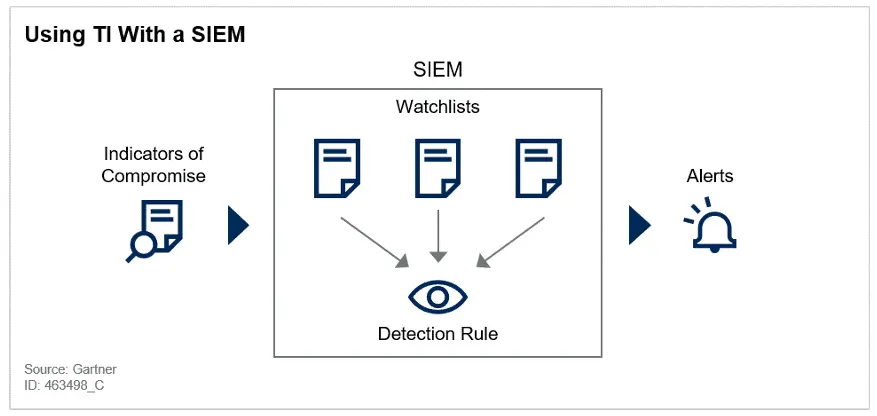Organisations are constantly grappling with the challenge of detecting and preventing cyber attacks in today’s digital age. Of the many tools that people use, threat intelligence is turning out to be one of the more important ones.

What Is Threat Intelligence?
When a cyber threat materialises, every second is crucial. Cyber Threat Intelligence (CTI) strengthens incident response, furnishing teams with critical information for prompt and effective action. This intelligence, pivotal for security operations, leverages open-source data and sophisticated analytics to mitigate false positives and prepare for future attacks.
Fundamentally, this form of intelligence serves as a comprehensive resource, compiling, evaluating, and converting raw data on threats from myriad sources into usable insights.
The result is a holistic understanding of potential threats, including malware and attacker tactics, enabling managed security services to anticipate, prepare, and respond effectively. A good threat intelligence strategy can greatly improve an organisation’s cybersecurity. It can be equally effective for minor security issues or more advanced threats.
And, it’s even more effective when supported by advanced technologies such as AI and machine learning.
The Importance of Cyber Threat Intelligence Tools
Understanding digital security starts with recognising that an operational threat intelligence program is essential in this field. It plays a crucial role by enabling organisations to collect, analyse data, and identify potential threats, offering a clear definition and explanation of the cybersecurity landscape. The benefits of threat intelligence are extensive:
Risk Reduction
Armed with comprehensive knowledge, organisations can address vulnerabilities and fortify systems more effectively. This proactive approach significantly diminishes the risk of data breaches and other threats, showcasing the benefits of enhancing security postures.
Cost Savings
By detecting threats early on or preventing them completely, businesses can achieve significant cost savings. This encompasses lower expenses related to threat detection, incident response, and the escalation of detection efforts, underlining the economic benefits.
Informed Decision-making
Operational Threat intelligence extends beyond mere detection and prevention of immediate threats. The insights derived facilitate informed strategic decision-making at various organisational levels, preparing entities not just to combat current threats but also to anticipate and mitigate future attacks. This strategic foresight is augmented by incorporating artificial intelligence to refine the threat intelligence lifecycle, making predictive analytics and threat anticipation more accurate.
Incident Response
When a cyber threat materialises, every second counts. The advent of a recent threat underscores the importance of readiness. Cyber Threat Intelligence (CTI) supports incident response by equipping teams with the information necessary for swift and effective action.
As part of a comprehensive cybersecurity strategy, CTI, enhanced by artificial intelligence, integrates seamlessly with tools like IBM Security QRadar SIEM and ThreatCloud AI. These platforms afford organisations a comprehensive overview of the cybersecurity domain, including real-time perspectives on existing threats, which is pivotal for strategic planning and operational readiness.
Vital data from official government websites, publications, and other sources are combined and analysed. They provide a real-time perspective on existing threats. This continuous learning cycle is central to the threat intelligence lifecycle, ensuring that security measures evolve in tandem with the changing threat environment.
In addition, CTI contributes significantly to education initiatives, equipping cyber security professionals with the latest trends and patterns.
Types of Threat Intelligence
CTI isn’t a one-size-fits-all type of solution. It continually adapts and evolves with the cyber Security landscape. It comes in three versions. Each has its strengths, catering to different aspects of an organisation’s cybersecurity posture.
Strategic Intelligence:
This type of intelligence focuses on providing high-level analysis for non-technical audiences. It typically targets executives and managers and helps in informing broader strategic decisions about the organisation’s security direction.
Strategic Intelligence goes beyond identifying and addressing specific threats. It examines more prominent trends and patterns. That way, it lends a broader perspective on the cyber security landscape and its correlation with business strategies.
Tactical Intelligence:
For a technically proficient audience like security teams or security system developers, tactical intelligence provides insights into near-future threats.
This kind of intelligence is highly practical. It identifies specific techniques, tactics, and procedures (TTPs) that threats may use, and offers immediate and concrete steps for mitigation.
Operational Intelligence:
Operational intelligence strives to provide insights into past cyber-attacks. It includes the tactics employed by the perpetrators, their potential targets and so on. This wealth of historical data helps in forming a clearer picture of the threats an organisation might face, promoting better preparation and targeted defence measures.
Which of these—tactical, operational, or strategic threat intelligence—does your business need?
That depends on its specific intelligence needs.
But, one thing is certain. Moving forward, these types of threat intelligence will continue to play integral roles in detecting and preventing cybersecurity threats.
Threat Intelligence Formats
Threat intelligence can be disseminated in various formats. Each one serves distinct objectives and caters to different audiences within the realm of cybersecurity practices. Understanding these formats is crucial for effectively utilising the intelligence gathered.
Indicators of Compromise
IOCs are forensic data that help a business identify potentially malicious activities on its systems. Common IOCs include IP addresses, URLs, hashes of malicious files, and email addresses associated with threats.
They are often shared in machine-readable formats like STIX (Structured Threat Information eXpression), enabling automated threat detection systems to process and use them efficiently.
Tactics, Techniques, and Procedures
These offer a more in-depth look at the behaviour of threat actors. They describe how adversaries operate and provide insights into their methods (techniques). They also offer an understanding of the tools they use (tactics) and the procedures they follow to execute attacks.
This understanding helps security teams anticipate and defend against attacks more strategically. These insights are commonly shared through frameworks like MITRE ATT&CK, which offers a comprehensive matrix of known adversary tactics and techniques.
Raw Data
This format includes unprocessed data collected from various sources. It includes logs, network traffic, and threat feeds. Raw data requires analysis to extract meaningful insights. However, it is valuable for businesses looking to conduct their own threat intelligence research and analysis.
Analysed Reports
These are comprehensive documents that provide analysis on specific threats, campaigns, or threat actors. Analysed reports translate raw data and IOCs into context-rich information, explaining the implications of threats, potential vulnerabilities exploited, and recommended mitigation strategies.
They are typically designed for strategic decision-making and accessible to technical and non-technical audiences.
For sharing and exchanging threat data, several common standards and protocols are used. These frameworks ensure compatibility and interoperability across different systems and tools, integral to security controls and the functionality of a threat intelligence platform.
Besides STIX, other formats include TAXII (Trusted Automated Exchange of Indicator Information) for automated exchange and sharing of threat intelligence and CybOX (Cyber Observable eXpression) for the specification of cyber observables.
By leveraging these various formats, companies can tailor their threat intelligence efforts to meet specific security needs. Threat intelligence enables a range from immediate, automated defensive actions to long-term strategic planning against cyber attacks. This approach not only addresses current vulnerabilities but also anticipates future cyber attacks, ensuring a robust and proactive defense posture.

Challenges of Utilising Threat Intelligence in Cybersecurity
Whilst the benefits of threat intelligence are undeniable, it’s only fair to address the challenges that come with utilising it effectively.
Need for Tailored Threat Management
Every organisation has its unique set of cyber security concerns and needs. If you opt for a generic solution, it may not work for your organisation’s unique vulnerabilities.
Therefore, threat intelligence needs to be tailored to fit the business’s specific needs.
Real-time Solutions
Cyber threats are not static; they evolve and adapt rapidly. Therefore, you need access to real-time threat data solutions. Furthermore, you must have the capacity to implement the insights gained promptly.
Capability to Gather and Analyse Data
Intelligence on threats is fundamentally anchored in data, necessitating that organisations possess appropriate technology and tools for efficient data collection and analytical processing. This encompasses a range from AI and machine learning for instantaneous insights to platforms like ThreatCloud AI and IBM Security Services for pursuing threats, including the identification of bad IP addresses and the analysis of data sources to combat a particular threat effectively.
Despite the hurdles involved, the advantages of threat intelligence remain substantial. With a comprehensive grasp of these challenges, organisations can enhance their preparedness and optimise their strategy for the effective application of threat intelligence.
Threat Intelligence With Rootshell
Rootshell Security elevates digital defences with tailored threat intelligence services, designed to provide meaningful insights for businesses. Our approach begins with understanding your unique risk profile, enabling customised intelligence gathering focused on the most relevant threats.
Using advanced analysis techniques, our experts uncover deep insights into adversaries’ tactics, offering clear, actionable recommendations. We ensure continuous monitoring and updates to keep pace with the evolving threat landscape. This is integrated seamlessly with your existing security infrastructure for enhanced protection.
Rootshell’s commitment to excellence means delivering not just data, but true cyber security resilience. Our services empower your business to anticipate and mitigate potential attacks, ensuring a robust security posture in the digital age.
Subscribe So You Never Miss an Update




